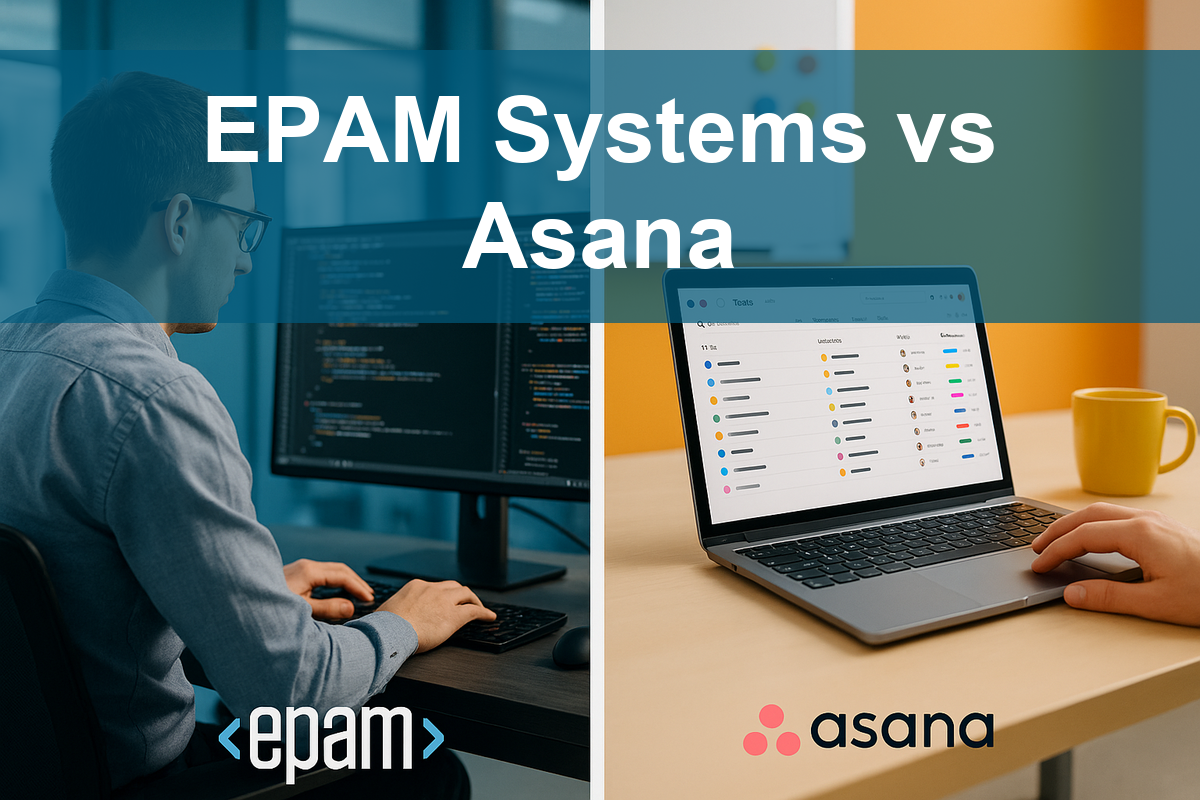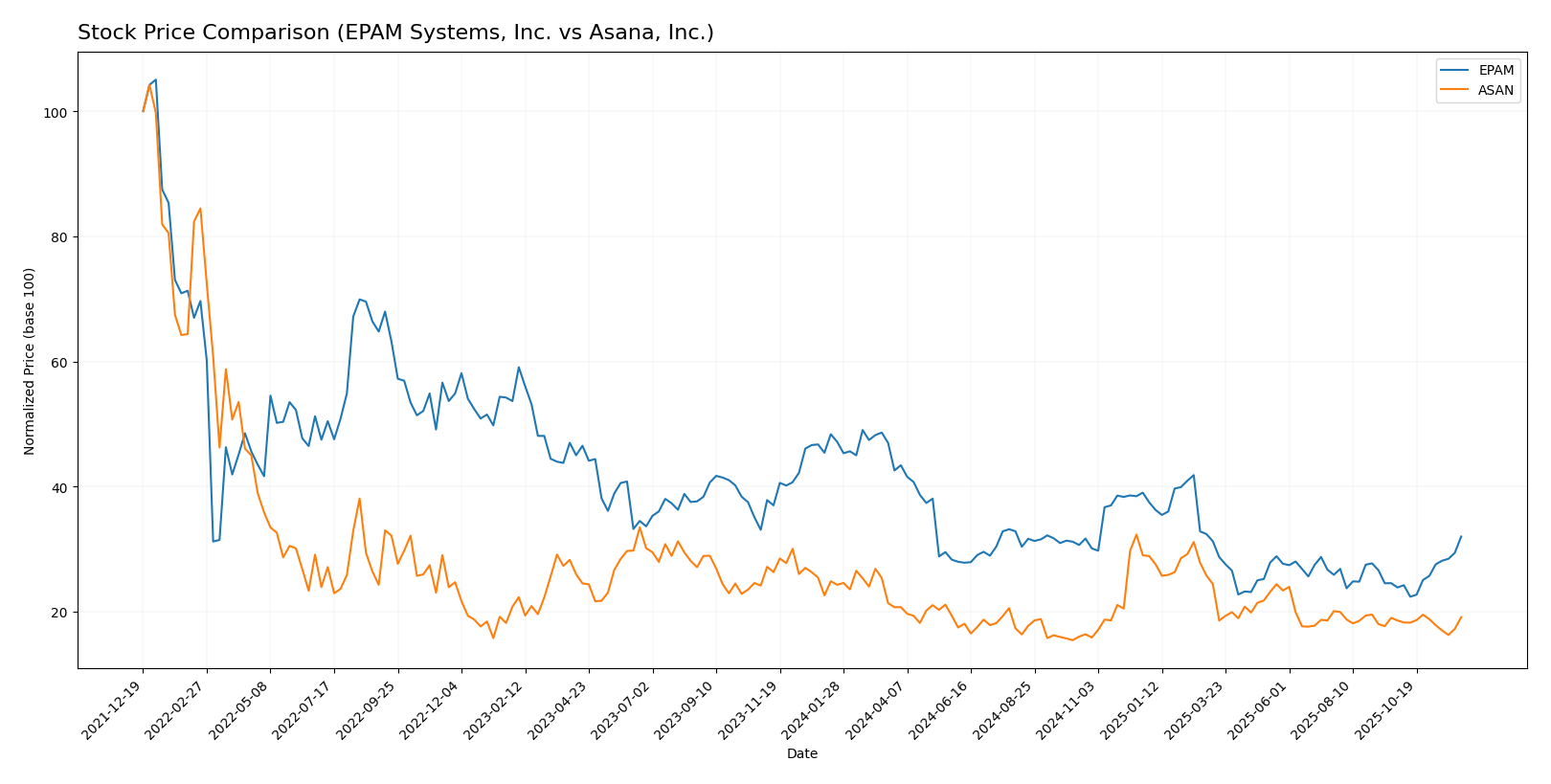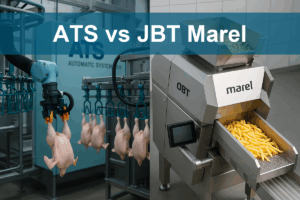In the dynamic world of technology, two companies stand out for their distinctive approaches to innovation and market presence: EPAM Systems, Inc. and Asana, Inc. Both operate within the technology sector but target different niches—EPAM focuses on digital platform engineering and software development, while Asana offers a robust work management platform. This comparison will explore their strategies and market overlap, helping you determine which company may be the most promising addition to your investment portfolio.

Table of contents
Company Overview
EPAM Overview
EPAM Systems, Inc. is a leading provider of digital platform engineering and software development services on a global scale. Founded in 1993 and headquartered in Newtown, PA, the company specializes in a comprehensive suite of engineering services that range from requirements analysis to platform selection and integration. EPAM serves diverse industries, including financial services, healthcare, and media, and is committed to enhancing customer operations through advanced technology solutions such as artificial intelligence and smart automation. With a market capitalization of approximately $11.24B, EPAM’s growth trajectory reflects its strong positioning in the competitive landscape of information technology services.
Asana Overview
Asana, Inc. is a prominent player in the work management software sector, helping teams streamline their workflows and manage projects efficiently. Established in 2008 and based in San Francisco, CA, Asana offers a platform that enables organizations to orchestrate tasks, manage product launches, and set strategic goals effectively. With a market cap of around $3.39B, it serves a wide array of industries, including technology, education, and healthcare. The company’s focus on enhancing collaboration and productivity positions it well within the burgeoning software application market.
Key similarities and differences
While both EPAM and Asana operate within the technology sector, their business models differ significantly. EPAM focuses on providing extensive engineering and consulting services across various industries, whereas Asana specializes in a specific software solution for work management. This distinction highlights EPAM’s broader service offerings compared to Asana’s targeted approach in enhancing team productivity.
Income Statement Comparison
The following table provides a side-by-side comparison of key income statement metrics for EPAM Systems, Inc. and Asana, Inc. for their most recent fiscal years.
| Metric | EPAM Systems, Inc. | Asana, Inc. |
|---|---|---|
| Market Cap | 11.24B | 3.39B |
| Revenue | 4.73B | 723.88M |
| EBITDA | 671.69M | -229.55M |
| EBIT | 544.58M | -247.09M |
| Net Income | 454.53M | -255.54M |
| EPS | 7.93 | -1.11 |
| Fiscal Year | 2024 | 2025 |
Interpretation of Income Statement
In analyzing the income statements for EPAM and Asana, EPAM demonstrates a stable revenue growth trend, with a slight increase from $4.69B in 2023 to $4.73B in 2024, alongside a rise in net income from $417.08M to $454.53M. This indicates improved operational efficiency and strong profit margins. In contrast, Asana continues to face challenges, reporting a decrease in net income to -$255.54M despite revenue growth from $652.50M to $723.88M. The negative EBITDA and EBIT suggest ongoing investment in growth, but at the cost of profitability. Therefore, while EPAM shows solid performance, Asana’s financial metrics raise caution for potential investors.
Financial Ratios Comparison
The table below presents a comparison of key financial ratios and metrics for EPAM Systems, Inc. (EPAM) and Asana, Inc. (ASAN).
| Metric | EPAM | ASAN |
|---|---|---|
| ROE | 12.52% | -112.31% |
| ROIC | 10.67% | -54.04% |
| P/E | 29.47 | -19.16 |
| P/B | 3.69 | 21.52 |
| Current Ratio | 2.96 | 1.44 |
| Quick Ratio | 2.96 | 1.44 |
| D/E | 0.04 | 1.18 |
| Debt-to-Assets | 3.44% | 30.11% |
| Interest Coverage | – | -72.42 |
| Asset Turnover | 0.99 | 0.81 |
| Fixed Asset Turnover | 14.07 | 2.76 |
| Payout ratio | 0% | 0% |
| Dividend yield | 0% | 0% |
Interpretation of Financial Ratios
EPAM shows solid financial health with a positive ROE and ROIC, indicating effective use of equity and capital. The current and quick ratios reveal good liquidity. In contrast, ASAN displays negative profitability metrics and high leverage, raising concerns about sustainability and financial stability. The stark difference in the P/E ratios highlights market expectations, with EPAM positioned more favorably.
Dividend and Shareholder Returns
EPAM Systems, Inc. does not pay dividends, reflecting a focus on reinvestment and growth strategies. With a dividend payout ratio of 0, the company allocates resources towards expanding its operations and enhancing shareholder value through share buybacks. On the other hand, Asana, Inc. also refrains from dividend payments, prioritizing investments in R&D and growth initiatives. This approach aligns with a long-term vision for shareholder value creation, as both companies emphasize reinvesting for future growth while managing risks associated with their cash flows.
Strategic Positioning
EPAM Systems, Inc. holds a significant position in the Information Technology Services market, with a market cap of $11.24B. Its engineering and software development services cater to diverse industries, allowing it to maintain a competitive edge amidst technological disruptions. In contrast, Asana, Inc., with a market cap of $3.39B, specializes in work management solutions, facing competitive pressure from emerging platforms. Both companies must continuously innovate to address market demands and sustain their respective market shares.
Stock Comparison
In this section, I will analyze the stock price movements and trading dynamics of EPAM Systems, Inc. (EPAM) and Asana, Inc. (ASAN) over the past year, highlighting key price changes and trading volume trends.

Trend Analysis
EPAM Systems, Inc. (EPAM) Over the past year, EPAM’s stock has experienced a significant decline, with a percentage change of -33.83%. This indicates a bearish trend characterized by acceleration, as evidenced by the highest price of 311.98 and a lowest price of 142.38. The stock’s volatility is notable, with a standard deviation of 45.25. The recent trend shows a positive shift, with a price change of 30.36% from September 21 to December 7, suggesting potential recovery, albeit still under bearish pressure.
Asana, Inc. (ASAN) ASAN has also faced a downturn, with an overall percentage change of -23.12%, categorizing it as bearish. The trend shows deceleration, and while the stock recorded a highest price of 24.15 and a lowest of 11.53, its volatility is lower, indicated by a standard deviation of 2.93. The recent trend from September 21 to December 7 shows a minimal increase of 0.6%, placing it within a neutral trend range, but it lacks the momentum needed for a bullish outlook.
Overall, both companies face challenges, but EPAM’s recent positive price movement provides a glimmer of potential recovery amidst a largely bearish environment.
Analyst Opinions
Recent analyst recommendations indicate a strong consensus for EPAM Systems, Inc. (EPAM) with an overall rating of A+. Analysts praise its solid return on equity and assets, suggesting a buy position. In contrast, Asana, Inc. (ASAN) has received a D+ rating, with analysts recommending a sell due to poor scores across key financial metrics. The consensus for EPAM is a buy, while ASAN is leaning towards a sell.
Stock Grades
The latest stock ratings for EPAM Systems, Inc. and Asana, Inc. reflect a cautious yet stable outlook from various grading companies.
EPAM Systems, Inc. Grades
| Grading Company | Action | New Grade | Date |
|---|---|---|---|
| Mizuho | maintain | Outperform | 2025-11-11 |
| JP Morgan | maintain | Overweight | 2025-11-07 |
| Morgan Stanley | maintain | Equal Weight | 2025-09-09 |
| JP Morgan | maintain | Overweight | 2025-08-20 |
| Barclays | maintain | Overweight | 2025-05-12 |
| Needham | maintain | Buy | 2025-05-09 |
| Guggenheim | maintain | Buy | 2025-05-09 |
| Piper Sandler | maintain | Neutral | 2025-05-09 |
| Morgan Stanley | maintain | Equal Weight | 2025-05-09 |
| Stifel | maintain | Buy | 2025-05-02 |
Asana, Inc. Grades
| Grading Company | Action | New Grade | Date |
|---|---|---|---|
| DA Davidson | maintain | Neutral | 2025-12-04 |
| Citigroup | maintain | Neutral | 2025-12-03 |
| UBS | maintain | Neutral | 2025-12-03 |
| RBC Capital | maintain | Underperform | 2025-12-03 |
| Morgan Stanley | maintain | Underweight | 2025-09-04 |
| Piper Sandler | maintain | Overweight | 2025-09-04 |
| Baird | maintain | Neutral | 2025-09-04 |
| JMP Securities | maintain | Market Outperform | 2025-06-04 |
| Scotiabank | maintain | Sector Perform | 2025-06-04 |
| Morgan Stanley | maintain | Underweight | 2025-06-04 |
Overall, EPAM Systems shows a consistent “Outperform” and “Overweight” sentiment from major analysts, indicating confidence in its performance. In contrast, Asana’s ratings are more mixed, with several “Neutral” and “Underperform” grades, suggesting caution among analysts regarding its future prospects.
Target Prices
Reliable target price data has been found for both EPAM Systems, Inc. and Asana, Inc. Below is the consensus from analysts:
| Company | Target High | Target Low | Consensus |
|---|---|---|---|
| EPAM Systems, Inc. | 185 | 175 | 180 |
| Asana, Inc. | 16 | 14 | 15 |
For EPAM, the target consensus of 180 indicates a potential decline from the current price of 203.5, suggesting that analysts are cautious about its near-term performance. Meanwhile, Asana’s target of 15 is slightly above its current price of 14.295, reflecting a more optimistic outlook, albeit within a challenging market.
Strengths and Weaknesses
The table below outlines the strengths and weaknesses of EPAM Systems, Inc. and Asana, Inc., providing a comparative overview for potential investors.
| Criterion | EPAM Systems, Inc. | Asana, Inc. |
|---|---|---|
| Diversification | Strong | Moderate |
| Profitability | High | Negative margins |
| Innovation | High | Moderate |
| Global presence | Extensive | Limited |
| Market Share | Strong | Growing |
| Debt level | Low (0.034) | High (0.301) |
Key takeaways show that while EPAM Systems demonstrates strong profitability and global presence, Asana faces challenges with profitability and a higher debt level. However, Asana shows potential for growth in market share and innovation.
Risk Analysis
Below is a summary table of the various risks faced by two companies, EPAM Systems, Inc. and Asana, Inc.
| Metric | EPAM Systems, Inc. | Asana, Inc. |
|---|---|---|
| Market Risk | Moderate | High |
| Regulatory Risk | Low | Moderate |
| Operational Risk | Moderate | High |
| Environmental Risk | Low | Low |
| Geopolitical Risk | Moderate | High |
In assessing the risks, Asana faces significant challenges, particularly in market and operational risks, which could impede its growth. In contrast, EPAM’s diversified service offerings mitigate some of these threats but still expose it to moderate market fluctuations.
Which one to choose?
In comparing EPAM Systems, Inc. (EPAM) and Asana, Inc. (ASAN), the fundamentals present a stark contrast. EPAM demonstrates solid profitability with a net profit margin of 9.6% and a robust return on equity (ROE) of 12.5%. Its A+ rating reflects strong financial health, while its price-to-earnings (P/E) ratio of approximately 29.5 suggests reasonable growth expectations. Conversely, Asana is struggling with negative profit margins and an overall D+ rating, indicating financial instability and a P/E ratio of -19.2, which raises concerns about its valuation and market dependence.
For growth-oriented investors, EPAM appears favorable, while those prioritizing stability may still find Asana attractive for its potential turnaround. However, the significant risks associated with Asana’s continued losses and reliance on market recovery cannot be overlooked.
Disclaimer: This article is not financial advice. Each investor is responsible for their own investment decisions.
Go further
I encourage you to read the complete analyses of EPAM Systems, Inc. and Asana, Inc. to enhance your investment decisions:



